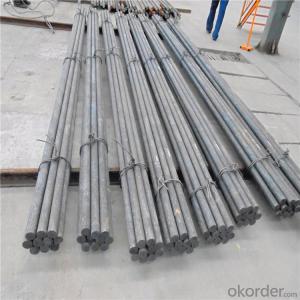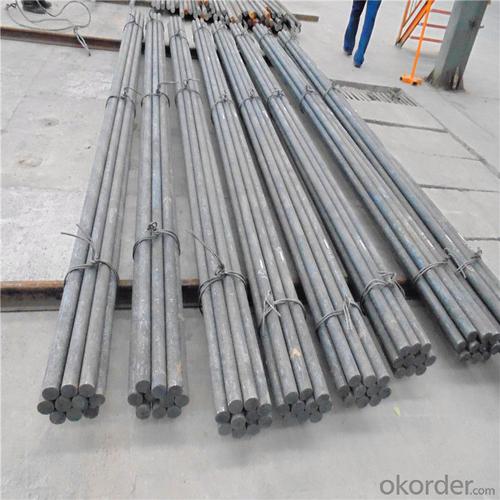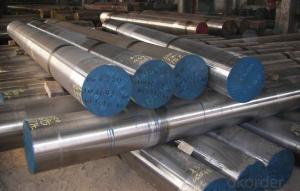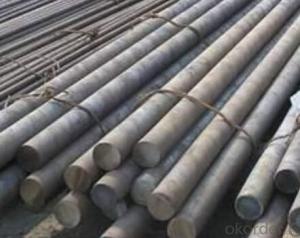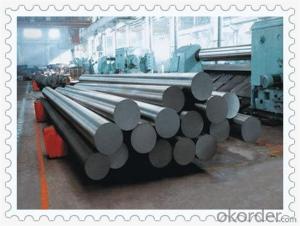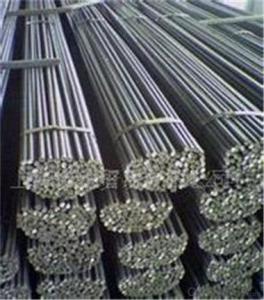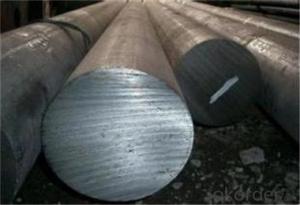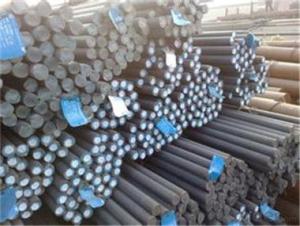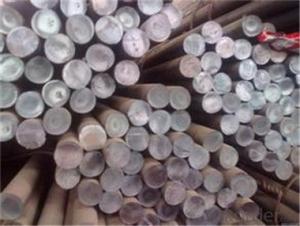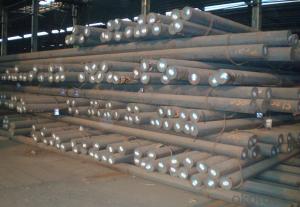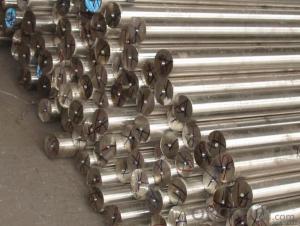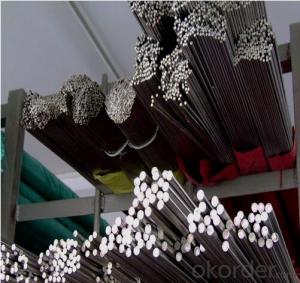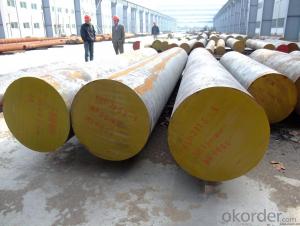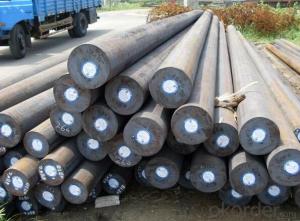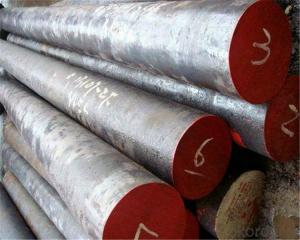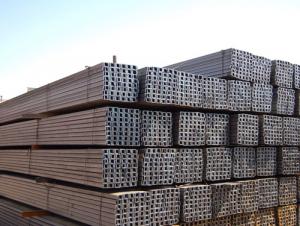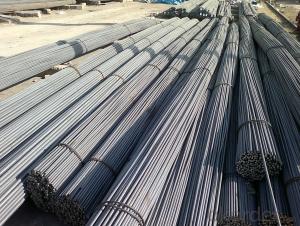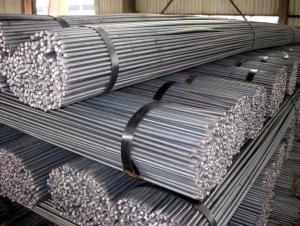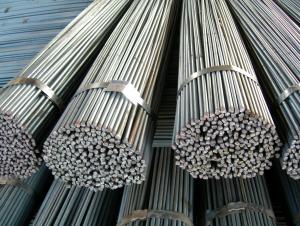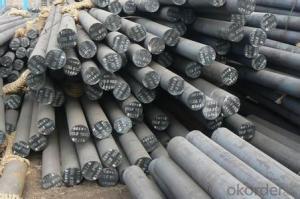Hot Forged Tool Steel Round Bar D-2, 42crmo4, ASTM A681, DIN 1.2379, SAE J437, J438
- Loading Port:
- Tianjin
- Payment Terms:
- TT OR LC
- Min Order Qty:
- 100 m.t.
- Supply Capability:
- 500000 m.t./month
OKorder Service Pledge
OKorder Financial Service
You Might Also Like
Specification
Hot Forged Tool Steel Round Bar D-2, 42crmo4, ASTM A6
Product Description of Hot Forged Tool Steel Round Bar D-2, 42crmo4, ASTM A6
1. Steel grade: ASTM4140, SCM440, 42CrMo, DIN1.7225
2. Length: 6M-12M
3. Diameter: 16mm-300mm
4. Product range: round bar, flat bar, square bar
5. Technique: Hot rolled, forged, cold drawn
Specification of Hot Forged Tool Steel Round Bar D-2, 42crmo4, ASTM A6
Material | SCM4140 | Round bar | Dia(mm) | 16-300mm |
Process | EAF + LF + VD + Forged + Heat Treatment (optional) | Length (mm) | Max 12m | |
Heat treatment | Normalized / Annealed / Quenched / tempered | Flat bar | Thickness(mm) | 8-500mm |
Delivery condition | Hot forged +Rough machined (black surface after Q/T)+ Turned (optional) | Width(mm) | 70-200mm | |
Test | Ultrasonic test according to SEP 1921-84 D/d | Length (mm) | Max 12m |
Chemical Composition of Hot Forged Tool Steel Round Bar D-2, 42crmo4, ASTM A6
C | Si | Mn | Cr | Mo | P | S |
0.38~0.43 | 0.15~0.35 | 0.75~1.00 | 0.8~1.1 | 0.15~0.25 | ≤0.035 | <0.04< td=""> |
Photo Show of Hot Forged Tool Steel Round Bar D-2, 42crmo4, ASTM A6
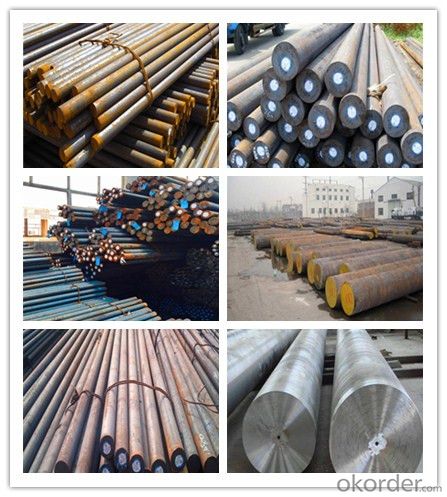
Packing and Delivery:
Packing in bundle package, or as customer's requirements.
Delivery Detail: 45 days after receiving the deposit.
Usage and Applications of Hot Forged Tool Steel Round Bar D-2, 42crmo4, ASTM A6
1. Steel round bar is used in a large number of architectural and engineering structures. Or it can be used in construction of plants for the production of steel house frames, high-voltage transmission towers, bridges, vehicles, boilers, containers, ships, etc.
2. And we can use this kind of product on the performance of the mechanical parts if the demand is not very high.
3. Some special material steel round bar can be used for main shaft of steamer, hummer shank, with big section and supper force.
Company Information
CNBM International Corporation is the most important trading platform of CNBM group.
Whith its advantages, CNBM International are mainly concentrate on Cement, Glass, Iron and Steel, Ceramics industries and devotes herself for supplying high qulity series of refractories as well as technical consultancies and logistics solutions.

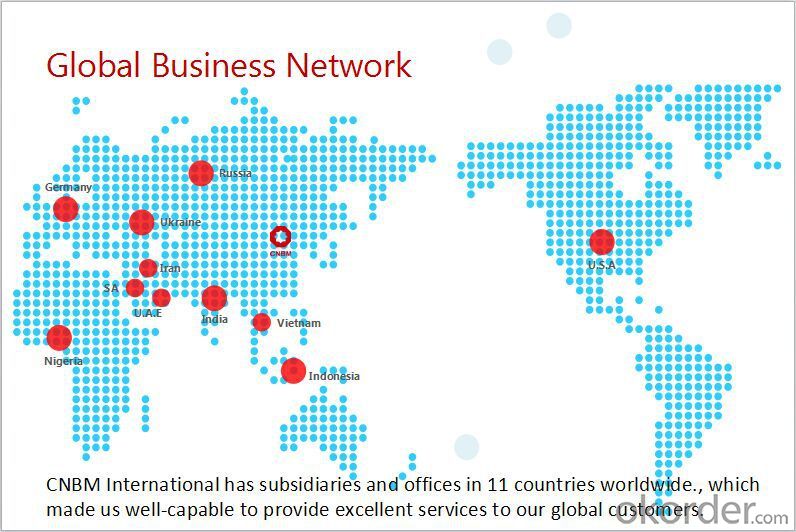
F A Q
1, Your advantages?
professional products inquiry, products knowledge train (for agents), smooth goods delivery, excellent customer solution proposale
2, Test & Certificate?
SGS test is available, customer inspection before shipping is welcome, third party inspection is no problem
3, Factory or Trading Company?
CNBM is a trading company but we have so many protocol factories and CNBM works as a trading department of these factories. Also CNBM is the holding company of many factories.
4, Payment Terms?
30% TT as deposit and 70% before delivery.
Irrevocable L/C at sight.
5, Trading Terms?
EXW, FOB, CIF, FFR, CNF
6, After-sale Service?
CNBM provides the services and support you need for every step of our cooperation. We're the business partner you can trust.
For any problem, please kindly contact us at any your convenient time.
We'll reply you in our first priority within 24 hours.
- Q: What are the different types of steel used in manufacturing round bars?
- There are several different types of steel that are commonly used in the manufacturing of round bars. Some of the most common types include: 1. Carbon Steel: This is the most common type of steel used in manufacturing round bars. It is made up primarily of iron and carbon, and is known for its strength and durability. Carbon steel round bars are used in a wide range of applications, including construction, automotive, and machinery. 2. Alloy Steel: Alloy steel is made by adding various elements to carbon steel, such as manganese, nickel, chromium, and molybdenum. These additional elements enhance the strength and hardness of the steel, making it ideal for applications that require high strength and resistance to wear and tear. 3. Stainless Steel: Stainless steel is a type of alloy steel that contains a minimum of 10.5% chromium. This high chromium content gives stainless steel its unique corrosion resistance properties, making it suitable for applications where exposure to moisture or chemicals is a concern. Stainless steel round bars are commonly used in the manufacturing of kitchen utensils, medical equipment, and automotive parts. 4. Tool Steel: Tool steel is a type of alloy steel that is specifically designed to have high hardness, wear resistance, and heat resistance. It is commonly used in the manufacturing of cutting tools, dies, and molds. Tool steel round bars are typically made from high-carbon steel with additional elements like tungsten, vanadium, or cobalt. 5. Bearing Steel: Bearing steel is a type of alloy steel that is specifically designed for use in bearing applications. It is characterized by its high hardness, wear resistance, and fatigue strength. Bearing steel round bars are commonly used in the manufacturing of bearings for various industries, including automotive, aerospace, and industrial machinery. These are just a few examples of the different types of steel used in the manufacturing of round bars. The specific type of steel chosen will depend on the desired properties and requirements of the application.
- Q: What is the tolerance for diameter in steel round bars?
- The tolerance for diameter in steel round bars can vary depending on the specific standards and requirements set by the manufacturer or industry. Generally, the tolerance for diameter in steel round bars is specified within a certain range to ensure the desired level of precision and consistency in the dimensions of the bars. This tolerance is usually expressed as a plus or minus value, indicating the acceptable deviation from the specified diameter. It is important to check the relevant industry standards or consult with the manufacturer to determine the specific tolerance for diameter in steel round bars, as it can differ based on the intended application and the manufacturing process used.
- Q: What is the carbon content in steel round bars?
- The amount of carbon in steel round bars varies depending on the grade and type of steel utilized, causing the carbon content in carbon steel round bars to typically range from 0.08% to 1.5%. A higher carbon content grants greater strength and hardness, albeit at the expense of weldability and ductility. The customer can specify the precise carbon content during the manufacturing process, tailoring it to their desired mechanical properties and application needs.
- Q: Can steel round bars be used for making power transmission systems?
- Certainly! Power transmission systems can indeed be made using steel round bars. Various industries commonly use steel round bars because of their remarkable strength and durability. Their capacity to endure high torque and load capacities makes them suitable for power transmission systems. Steel round bars can be machined and shaped into different sizes and forms, offering versatility for diverse power transmission applications. Moreover, steel exhibits exceptional wear resistance and can withstand severe operating conditions, rendering it an ideal material for power transmission systems that necessitate enduring performance.
- Q: What are the advantages of using precipitation-hardening steel round bars?
- There are several advantages of using precipitation-hardening steel round bars. Firstly, these bars offer high strength and toughness, making them suitable for applications that require heavy load-bearing capacity. Secondly, they have excellent corrosion resistance, making them ideal for use in harsh environments or exposed to corrosive elements. Additionally, precipitation-hardening steel round bars can be easily machined and formed into various shapes, providing versatility in design and manufacturing. Lastly, these bars possess good dimensional stability, ensuring consistent performance and reliable results in critical applications.
- Q: What are the different grades of heat-treated steel round bars?
- The different grades of heat-treated steel round bars include, but are not limited to, AISI 4140, AISI 4340, AISI 8620, and ASTM A105.
- Q: How do steel round bars perform under torsion or twisting forces?
- Steel round bars perform very well under torsion or twisting forces due to their high tensile strength and excellent resistance to deformation. They have a strong resistance to twisting and can withstand significant torque without breaking or deforming. This makes them suitable for applications where torsional stresses are involved, such as in shafts, axles, and other mechanical components.
- Q: What are the different surface roughness options for steel round bars?
- There are several different surface roughness options available for steel round bars. These options are typically determined by the manufacturing process and the desired end-use of the steel bars. 1. Hot Rolled: Hot rolled steel round bars have a rough and scaled surface finish. This is due to the high temperature at which the bars are formed, which causes the surface to oxidize and form a layer of scale. This roughness can vary depending on the specific manufacturing process. 2. Cold Drawn: Cold drawn steel round bars are processed at room temperature, resulting in a smoother surface finish compared to hot rolled bars. The cold drawing process involves pulling the steel bars through a die to reduce their diameter, resulting in a more uniform and consistent surface roughness. 3. Peeled and Polished: Peeled and polished steel round bars undergo a secondary process to remove the outer layer of scale or surface defects. This process typically involves peeling the outer layer and then polishing the surface to achieve a smoother and more refined finish. This option provides a high-quality surface with minimal imperfections. 4. Ground: Ground steel round bars are processed through a grinding machine to achieve a precise and smooth surface finish. This process removes any surface defects and irregularities, resulting in a consistent and uniform surface roughness. Ground bars are often used in applications where dimensional accuracy and a smooth surface are required. 5. Turned and Polished: Turned and polished steel round bars are processed on a lathe machine, where the outer layer is removed by turning the bars against a cutting tool. This process results in a smooth and polished surface finish. Turned and polished bars are commonly used in applications where aesthetics and a high-quality surface finish are important. Overall, the choice of surface roughness option for steel round bars depends on the specific requirements of the application. Factors such as dimensional accuracy, surface finish, and aesthetics play a role in determining the most suitable option for a given use case.
- Q: How do steel round bars compare to brass or copper bars?
- Steel round bars, when compared to brass or copper bars, exhibit several key differences. Firstly, steel bars are known for their superior strength and durability. They have a high tensile strength and are capable of withstanding heavy loads and impacts, making them ideal for applications that require robustness and toughness. On the other hand, brass and copper bars are relatively softer and less rigid, making them more suitable for applications that prioritize malleability and electrical conductivity. Another significant difference lies in their corrosion resistance. While brass and copper bars are known for their excellent corrosion resistance, steel bars, particularly carbon steel, are more vulnerable to rusting. However, stainless steel round bars are highly resistant to corrosion due to the presence of chromium, making them a suitable alternative to brass or copper bars in environments where corrosion is a concern. In terms of cost, steel round bars are generally more economical compared to brass or copper bars. This is primarily due to the higher availability and lower production costs associated with steel. Brass and copper, being non-ferrous metals, are less abundant and require more complex extraction and refining processes, making them relatively more expensive. Furthermore, steel round bars offer a wide range of mechanical properties, such as different grades and compositions, allowing for customization based on specific application requirements. Conversely, brass and copper bars have more limited options in terms of strength and hardness variations. Overall, the choice between steel, brass, or copper round bars depends on the specific application and desired properties. Steel bars are preferred for their strength, durability, and cost-effectiveness, while brass or copper bars are favored for their malleability, electrical conductivity, and corrosion resistance.
- Q: What are the advantages of using nickel-chromium-molybdenum alloy steel round bars?
- Nickel-chromium-molybdenum alloy steel round bars offer numerous benefits: 1. Exceptional strength and durability: These round bars possess outstanding mechanical properties, including high tensile strength and hardness. As a result, they are ideal for applications that demand robust and long-lasting materials. 2. Enhanced resistance to corrosion: The inclusion of nickel and chromium in the alloy steel composition improves its ability to withstand corrosion. This makes it suitable for use in environments exposed to harsh chemicals or moisture. Consequently, the lifespan of these round bars is extended, reducing the need for frequent replacements. 3. Impressive heat resistance: Nickel-chromium-molybdenum alloy steel round bars can endure high temperatures without compromising their structural integrity. This makes them well-suited for applications involving extreme heat, such as the manufacturing of boilers, heat exchangers, and other heat-resistant equipment. 4. Versatility in fabrication: These round bars can be easily machined and fabricated, enabling the production of various shapes and sizes. This versatility makes them applicable across a wide range of industries, including aerospace, automotive, oil and gas, and construction. 5. Resistance to fatigue: The alloy composition of nickel-chromium-molybdenum steel enhances its resistance to fatigue, making it ideal for applications subjected to cyclic loading or repeated stress. This ensures that the round bars can withstand prolonged use without experiencing fatigue failure. 6. Excellent weldability: Nickel-chromium-molybdenum alloy steel round bars exhibit good weldability, facilitating easy joining or fabrication processes. This makes them suitable for applications that require welding or other forms of joining, providing flexibility in design and construction. In conclusion, the advantages of nickel-chromium-molybdenum alloy steel round bars make them a preferred choice in industries where strength, durability, corrosion resistance, heat resistance, versatility, fatigue resistance, and weldability are crucial factors for success.
Send your message to us
Hot Forged Tool Steel Round Bar D-2, 42crmo4, ASTM A681, DIN 1.2379, SAE J437, J438
- Loading Port:
- Tianjin
- Payment Terms:
- TT OR LC
- Min Order Qty:
- 100 m.t.
- Supply Capability:
- 500000 m.t./month
OKorder Service Pledge
OKorder Financial Service
Similar products
Hot products
Hot Searches
Related keywords
